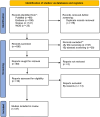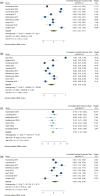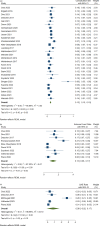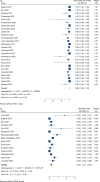Safety and efficacy of flow redirection endoluminal device (FRED) for treatment of intracranial aneurysm; A systematic review and meta-analysis
- PMID: 39102710
- PMCID: PMC11571416
- DOI: 10.1177/19714009241269460
Safety and efficacy of flow redirection endoluminal device (FRED) for treatment of intracranial aneurysm; A systematic review and meta-analysis
Abstract
BackgroundPrevious research has shown promising results for treating intracranial aneurysms (IAs) with a flow redirection endoluminal device (FRED). In this systematic review and meta-analysis, we aimed to assess the safety and efficacy of this device by providing pooled estimates using the data from previous studies.MethodsA systematic literature search of Web of Sciences, PubMed, Scopus, and Embase was performed until October 8th, 2023. After selecting the final articles, relevant data were extracted. Parameters relating to safety and efficacy were pooled using STATA software. Heterogeneity was assessed using I-squared and Cochran's Q. Funnel plots and Egger's regression methods were used to evaluate publication bias. Sensitivity analysis was also performed using the leave-one-out method.ResultsThe data of 37 studies were used for meta-analysis. The rates of immediate adequate occlusion and complete occlusion were 0.51 (95% CI: 0.31-0.71) and 0.34 (95% CI: 0.16-0.53), respectively, while the rates of the adequate and complete occlusion at the latest follow-up were 0.90 (95% CI: 0.84-0.94) and 0.75 (95% CI: 0.65-0.84), respectively. The periprocedural complications rate was 0.04 (95% CI: 0.03-0.06), and the overall complications rate was 0.12 (95% CI: 0.09-0.15). The rate of good functional outcome was 0.99 (95% CI: 0.99-1.00) and the successful implantation rate was 1.00 (95% CI: 1.00-1.00). There was substantial heterogeneity among the reports for most of the evaluated parameters.ConclusionFRED had high safety and efficacy in treating IAs, as evidenced by its high occlusion and low complication rates.
Keywords: Flow-diverter; aneurysm; brain; endovascular; stent.
Conflict of interest statement
Declaration of conflicting interestsThe author(s) declared no potential conflicts of interest with respect to the research, authorship, and/or publication of this article.
Figures





Similar articles
-
Comparison between pipeline embolization device (PED) versus flow redirection endoluminal device (FRED) for intracranial aneurysms: a comprehensive systematic review and meta-analysis.Neurosurg Rev. 2025 Jun 3;48(1):475. doi: 10.1007/s10143-025-03595-x. Neurosurg Rev. 2025. PMID: 40456928 Free PMC article. Review.
-
Pipeline Embolization Device and Flow Re-Direction Endoluminal Device for Intracranial Aneurysms: A Comparative Systematic Review and Meta-Analysis Study.World Neurosurg. 2024 Sep;189:399-409.e18. doi: 10.1016/j.wneu.2024.06.100. Epub 2024 Jun 24. World Neurosurg. 2024. PMID: 38925243
-
Initial Experience with the Pipeline Vantage Flow Diverter for Intracranial Aneurysms: A Systematic Review and Meta-Analysis.AJNR Am J Neuroradiol. 2025 Mar 4;46(3):510-516. doi: 10.3174/ajnr.A8555. AJNR Am J Neuroradiol. 2025. PMID: 40016131
-
First United States multicenter experience with the new-generation FRED X surface-modified flow diversion stent: feasibility, safety, and short-term efficacy.J Neurosurg. 2023 Oct 6;140(4):1054-1063. doi: 10.3171/2023.7.JNS23966. Print 2024 Apr 1. J Neurosurg. 2023. PMID: 37856406
-
Long-term safety and efficacy of the FRED X flow diverter for intracranial aneurysms: a multicenter study of 154 patients.J Neurosurg. 2025 Feb 28;143(1):232-242. doi: 10.3171/2024.10.JNS241233. Print 2025 Jul 1. J Neurosurg. 2025. PMID: 40020234
Cited by
-
A systematic review of the Contour Neurovascular System for the treatment of intracranial aneurysms.Neuroradiol J. 2025 Apr 22:19714009251336321. doi: 10.1177/19714009251336321. Online ahead of print. Neuroradiol J. 2025. PMID: 40262194 Free PMC article. Review.
-
Endovascular treatment of intracranial aneurysms with silk vista baby flow diverter: A systematic review and meta-analysis.Neuroradiol J. 2025 Feb 27:19714009251324324. doi: 10.1177/19714009251324324. Online ahead of print. Neuroradiol J. 2025. PMID: 40016880 Free PMC article. Review.
-
Comparison between pipeline embolization device (PED) versus flow redirection endoluminal device (FRED) for intracranial aneurysms: a comprehensive systematic review and meta-analysis.Neurosurg Rev. 2025 Jun 3;48(1):475. doi: 10.1007/s10143-025-03595-x. Neurosurg Rev. 2025. PMID: 40456928 Free PMC article. Review.
References
-
- Zhang Y, Zhou Y, Yang P, et al. Comparison of the flow diverter and stent-assisted coiling in large and giant aneurysms: safety and efficacy based on a propensity score-matched analysis. Eur Radiol 2016; 26: 2369–2377. - PubMed
-
- Zhou G, Zhu Y-Q, Su M, et al. Flow-diverting devices versus coil embolization for intracranial aneurysms: a systematic literature review and meta-analysis. World Neurosurg 2016; 88: 640–645. - PubMed
Publication types
MeSH terms
LinkOut - more resources
Full Text Sources
Medical

